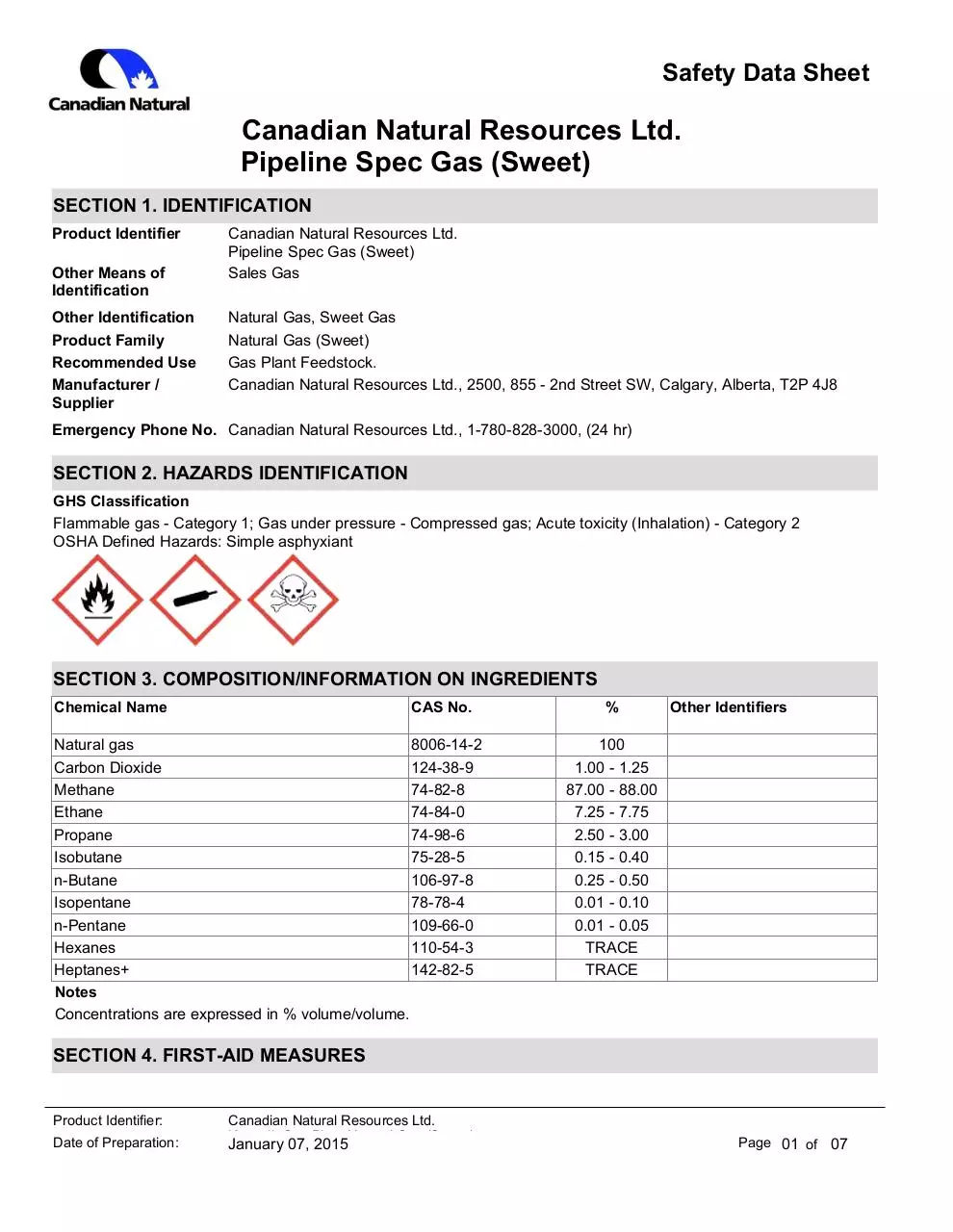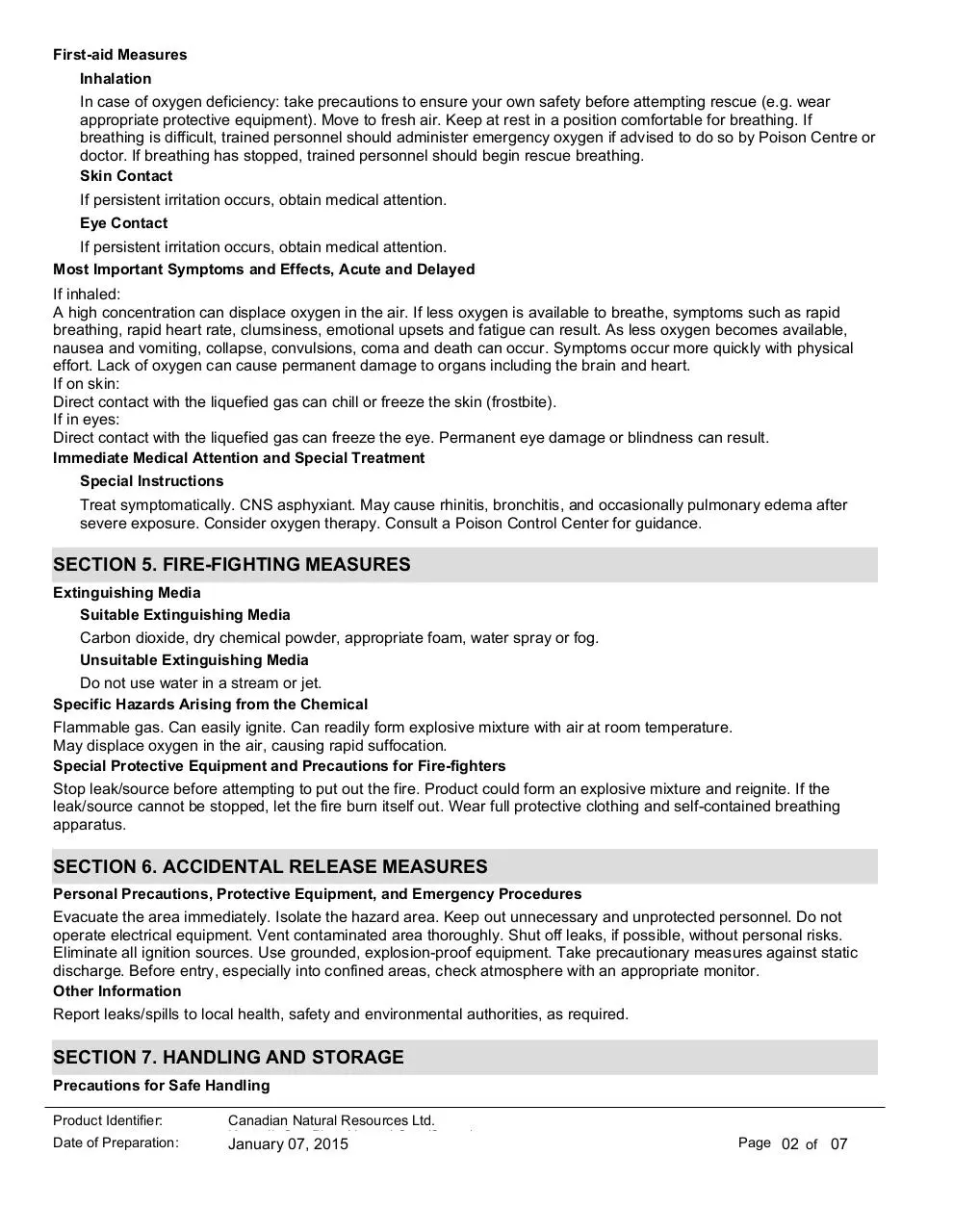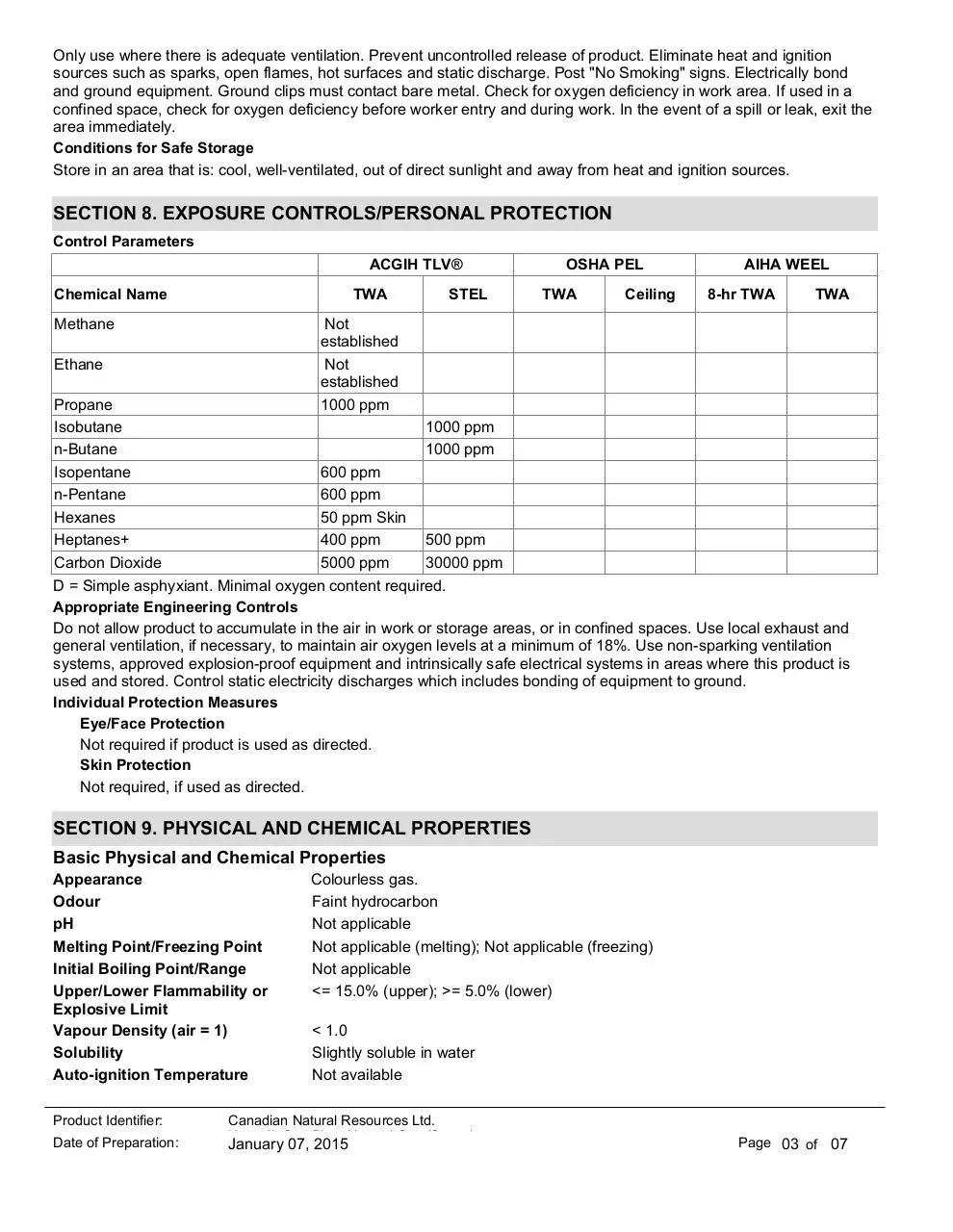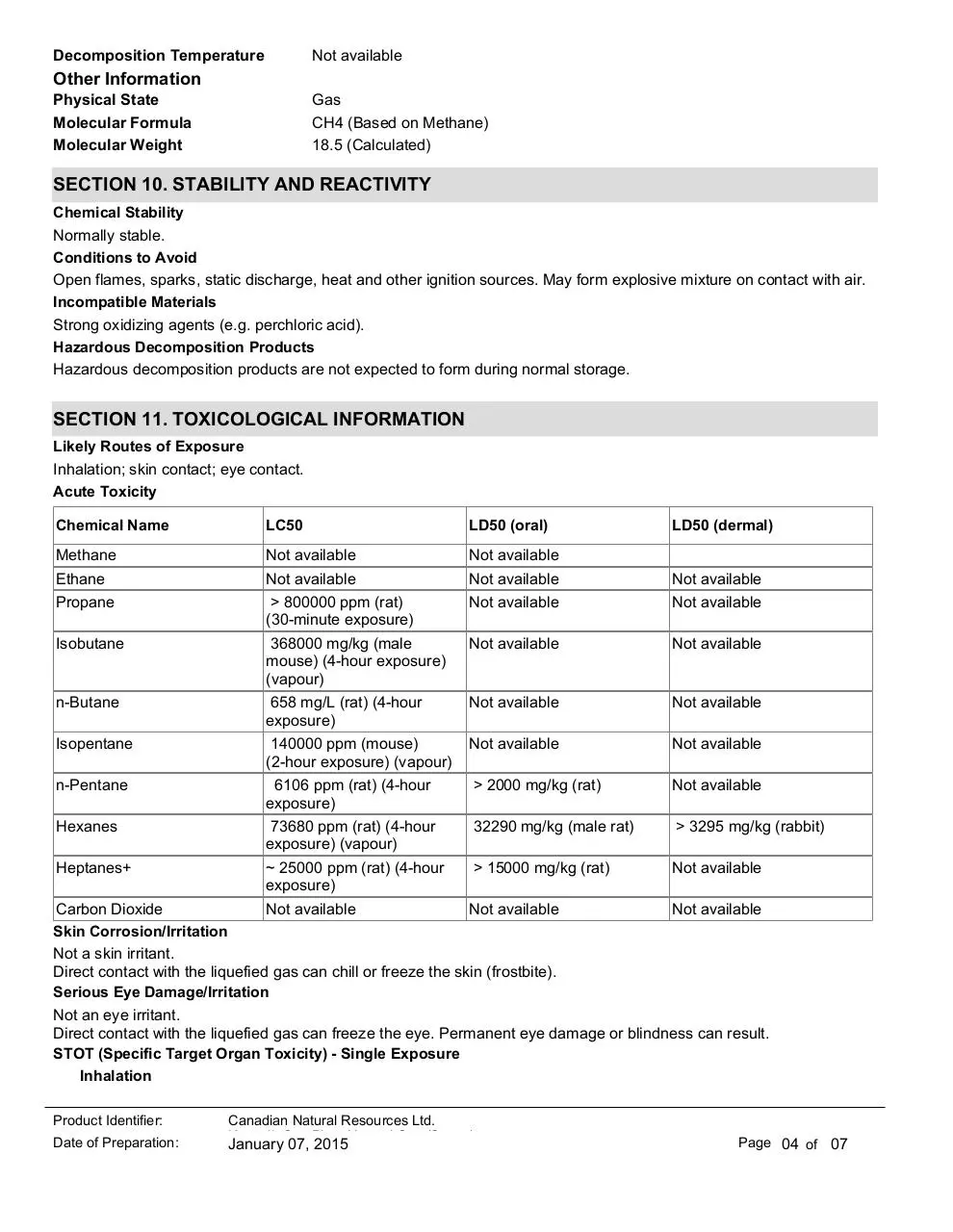CNRL Pipeline Spec Gas (Sweet) SDS (PDF)
File information
This PDF 1.7 document has been generated by GrapeCity ActiveReports (tm) for .NET, and has been sent on pdf-archive.com on 09/01/2018 at 20:39, from IP address 204.12.x.x.
The current document download page has been viewed 877 times.
File size: 161.42 KB (7 pages).
Privacy: public file





File preview
Safety Data Sheet
Canadian Natural Resources Ltd.
Pipeline Spec Gas (Sweet)
SECTION 1. IDENTIFICATION
Product Identifier
Other Means of
Identification
Other Identification
Product Family
Recommended Use
Manufacturer /
Supplier
Canadian Natural Resources Ltd.
Pipeline Spec Gas (Sweet)
Sales Gas
Natural Gas, Sweet Gas
Natural Gas (Sweet)
Gas Plant Feedstock.
Canadian Natural Resources Ltd., 2500, 855 - 2nd Street SW, Calgary, Alberta, T2P 4J8
Emergency Phone No. Canadian Natural Resources Ltd., 1-780-828-3000, (24 hr)
SECTION 2. HAZARDS IDENTIFICATION
GHS Classification
Flammable gas - Category 1; Gas under pressure - Compressed gas; Acute toxicity (Inhalation) - Category 2
OSHA Defined Hazards: Simple asphyxiant
SECTION 3. COMPOSITION/INFORMATION ON INGREDIENTS
Chemical Name
CAS No.
Natural gas
8006-14-2
Carbon Dioxide
124-38-9
Methane
74-82-8
Ethane
74-84-0
Propane
74-98-6
Isobutane
75-28-5
n-Butane
106-97-8
Isopentane
78-78-4
n-Pentane
109-66-0
Hexanes
110-54-3
Heptanes+
142-82-5
Notes
Concentrations are expressed in % volume/volume.
%
Other Identifiers
100
1.00 - 1.25
87.00 - 88.00
7.25 - 7.75
2.50 - 3.00
0.15 - 0.40
0.25 - 0.50
0.01 - 0.10
0.01 - 0.05
TRACE
TRACE
SECTION 4. FIRST-AID MEASURES
First-aid Measures
Product Identifier:
Date of Preparation:
Canadian Natural Resources Ltd.
Knopcik Gas Plant Natural Gas (Sweet)
January 07, 2015
Page 01 of 07
SECTION 4. FIRST-AID MEASURES
First-aid Measures
Inhalation
In case of oxygen deficiency: take precautions to ensure your own safety before attempting rescue (e.g. wear
appropriate protective equipment). Move to fresh air. Keep at rest in a position comfortable for breathing. If
breathing is difficult, trained personnel should administer emergency oxygen if advised to do so by Poison Centre or
doctor. If breathing has stopped, trained personnel should begin rescue breathing.
Skin Contact
If persistent irritation occurs, obtain medical attention.
Eye Contact
If persistent irritation occurs, obtain medical attention.
Most Important Symptoms and Effects, Acute and Delayed
If inhaled:
A high concentration can displace oxygen in the air. If less oxygen is available to breathe, symptoms such as rapid
breathing, rapid heart rate, clumsiness, emotional upsets and fatigue can result. As less oxygen becomes available,
nausea and vomiting, collapse, convulsions, coma and death can occur. Symptoms occur more quickly with physical
effort. Lack of oxygen can cause permanent damage to organs including the brain and heart.
If on skin:
Direct contact with the liquefied gas can chill or freeze the skin (frostbite).
If in eyes:
Direct contact with the liquefied gas can freeze the eye. Permanent eye damage or blindness can result.
Immediate Medical Attention and Special Treatment
Special Instructions
Treat symptomatically. CNS asphyxiant. May cause rhinitis, bronchitis, and occasionally pulmonary edema after
severe exposure. Consider oxygen therapy. Consult a Poison Control Center for guidance.
SECTION 5. FIRE-FIGHTING MEASURES
Extinguishing Media
Suitable Extinguishing Media
Carbon dioxide, dry chemical powder, appropriate foam, water spray or fog.
Unsuitable Extinguishing Media
Do not use water in a stream or jet.
Specific Hazards Arising from the Chemical
Flammable gas. Can easily ignite. Can readily form explosive mixture with air at room temperature.
May displace oxygen in the air, causing rapid suffocation.
Special Protective Equipment and Precautions for Fire-fighters
Stop leak/source before attempting to put out the fire. Product could form an explosive mixture and reignite. If the
leak/source cannot be stopped, let the fire burn itself out. Wear full protective clothing and self-contained breathing
apparatus.
SECTION 6. ACCIDENTAL RELEASE MEASURES
Personal Precautions, Protective Equipment, and Emergency Procedures
Evacuate the area immediately. Isolate the hazard area. Keep out unnecessary and unprotected personnel. Do not
operate electrical equipment. Vent contaminated area thoroughly. Shut off leaks, if possible, without personal risks.
Eliminate all ignition sources. Use grounded, explosion-proof equipment. Take precautionary measures against static
discharge. Before entry, especially into confined areas, check atmosphere with an appropriate monitor.
Other Information
Report leaks/spills to local health, safety and environmental authorities, as required.
SECTION 7. HANDLING AND STORAGE
Precautions for Safe Handling
Only use where there is adequate ventilation. Prevent uncontrolled release of product. Eliminate heat and ignition
Product
Canadian
Natural
Ltd. static discharge. Post "No Smoking" signs. Electrically bond
sourcesIdentifier:
such as sparks, open
flames,
hot Resources
surfaces and
Knopcik
Gas
Plant
Natural
Gas
(Sweet)
Date
of Preparation:
Page If02
and ground
equipment. Ground
clips
used
January
07,must
2015contact bare metal. Check for oxygen deficiency in work area.
07a
of in
confined space, check for oxygen deficiency before worker entry and during work. In the event of a spill or leak, exit the
area immediately.
Precautions for Safe Handling
Only use where there is adequate ventilation. Prevent uncontrolled release of product. Eliminate heat and ignition
sources such as sparks, open flames, hot surfaces and static discharge. Post "No Smoking" signs. Electrically bond
and ground equipment. Ground clips must contact bare metal. Check for oxygen deficiency in work area. If used in a
confined space, check for oxygen deficiency before worker entry and during work. In the event of a spill or leak, exit the
area immediately.
Conditions for Safe Storage
Store in an area that is: cool, well-ventilated, out of direct sunlight and away from heat and ignition sources.
SECTION 8. EXPOSURE CONTROLS/PERSONAL PROTECTION
Control Parameters
ACGIH TLV®
Chemical Name
TWA
Methane
STEL
OSHA PEL
TWA
Ceiling
AIHA WEEL
8-hr TWA
TWA
Not
established
Not
established
1000 ppm
Ethane
Propane
Isobutane
n-Butane
Isopentane
n-Pentane
Hexanes
Heptanes+
Carbon Dioxide
1000 ppm
1000 ppm
600 ppm
600 ppm
50 ppm Skin
400 ppm
5000 ppm
500 ppm
30000 ppm
D = Simple asphyxiant. Minimal oxygen content required.
Appropriate Engineering Controls
Do not allow product to accumulate in the air in work or storage areas, or in confined spaces. Use local exhaust and
general ventilation, if necessary, to maintain air oxygen levels at a minimum of 18%. Use non-sparking ventilation
systems, approved explosion-proof equipment and intrinsically safe electrical systems in areas where this product is
used and stored. Control static electricity discharges which includes bonding of equipment to ground.
Individual Protection Measures
Eye/Face Protection
Not required if product is used as directed.
Skin Protection
Not required, if used as directed.
SECTION 9. PHYSICAL AND CHEMICAL PROPERTIES
Basic Physical and Chemical Properties
Appearance
Odour
pH
Melting Point/Freezing Point
Initial Boiling Point/Range
Upper/Lower Flammability or
Explosive Limit
Vapour Density (air = 1)
Solubility
Auto-ignition Temperature
Decomposition Temperature
Product Identifier:
Date of Preparation:
Colourless gas.
Faint hydrocarbon
Not applicable
Not applicable (melting); Not applicable (freezing)
Not applicable
<= 15.0% (upper); >= 5.0% (lower)
< 1.0
Slightly soluble in water
Not available
Not available
Canadian Natural Resources Ltd.
Knopcik Gas Plant Natural Gas (Sweet)
January 07, 2015
Page 03 of 07
Decomposition Temperature
Not available
Other Information
Physical State
Molecular Formula
Molecular Weight
Gas
CH4 (Based on Methane)
18.5 (Calculated)
SECTION 10. STABILITY AND REACTIVITY
Chemical Stability
Normally stable.
Conditions to Avoid
Open flames, sparks, static discharge, heat and other ignition sources. May form explosive mixture on contact with air.
Incompatible Materials
Strong oxidizing agents (e.g. perchloric acid).
Hazardous Decomposition Products
Hazardous decomposition products are not expected to form during normal storage.
SECTION 11. TOXICOLOGICAL INFORMATION
Likely Routes of Exposure
Inhalation; skin contact; eye contact.
Acute Toxicity
Chemical Name
LC50
LD50 (oral)
LD50 (dermal)
Methane
Ethane
Propane
Not available
Not available
> 800000 ppm (rat)
(30-minute exposure)
Not available
Not available
Not available
Not available
Not available
Isobutane
368000 mg/kg (male
mouse) (4-hour exposure)
(vapour)
Not available
Not available
n-Butane
658 mg/L (rat) (4-hour
exposure)
Not available
Not available
Isopentane
140000 ppm (mouse)
(2-hour exposure) (vapour)
Not available
Not available
n-Pentane
6106 ppm (rat) (4-hour
exposure)
> 2000 mg/kg (rat)
Not available
Hexanes
73680 ppm (rat) (4-hour
exposure) (vapour)
32290 mg/kg (male rat)
> 3295 mg/kg (rabbit)
Heptanes+
~ 25000 ppm (rat) (4-hour
exposure)
> 15000 mg/kg (rat)
Not available
Carbon Dioxide
Not available
Not available
Not available
Skin Corrosion/Irritation
Not a skin irritant.
Direct contact with the liquefied gas can chill or freeze the skin (frostbite).
Serious Eye Damage/Irritation
Not an eye irritant.
Direct contact with the liquefied gas can freeze the eye. Permanent eye damage or blindness can result.
STOT (Specific Target Organ Toxicity) - Single Exposure
Inhalation
A high concentration can displace oxygen in the air. If less oxygen is available to breathe, symptoms such as rapid
breathing,
rapid heart Canadian
rate, clumsiness,
emotional
upsets and fatigue can result. As less oxygen becomes available,
Product
Identifier:
Natural Resources
Ltd.
nausea and vomiting, Knopcik
collapse,
convulsions,
coma
and death can occur. Symptoms occur more quickly with
Gas
Plant
Natural
Gas
(Sweet)
Date of Preparation:
Page 04 of 07
January 07, 2015
physical effort. Lack of oxygen can cause permanent damage to organs including the brain and heart.
At high concentrations: depression of the central nervous system, resulting in dizziness, light-headedness,
headache, and nausea.
A high concentration can displace oxygen in the air. If less oxygen is available to breathe, symptoms such as rapid
breathing, rapid heart rate, clumsiness, emotional upsets and fatigue can result. As less oxygen becomes available,
nausea and vomiting, collapse, convulsions, coma and death can occur. Symptoms occur more quickly with
physical effort. Lack of oxygen can cause permanent damage to organs including the brain and heart.
At high concentrations: depression of the central nervous system, resulting in dizziness, light-headedness,
headache, and nausea.
STOT (Specific Target Organ Toxicity) - Repeated Exposure
Not expected to be a hazard.
None known.
Respiratory and/or Skin Sensitization
Not a skin sensitizer.
Carcinogenicity
Not expected to be a hazard.
Not a carcinogen.
Reproductive Toxicity
Development of Offspring
Not expected to be a hazard.
Does not harm the unborn child.
Sexual Function and Fertility
Not expected to be a hazard.
Not known to be a reproductive hazard.
Germ Cell Mutagenicity
Not expected to be a hazard.
Not known to be a mutagen.
Interactive Effects
Not expected to be a hazard.
Other Information
High gas concentrations will displace available oxygen from the air; unconsciousness and death may occur suddenly
from lack of oxygen.
SECTION 12. ECOLOGICAL INFORMATION
Toxicity
Not harmful to aquatic organisms.
Persistence and Degradability
No ingredient of this product or its degradation products is known to be highly persistent.
Bioaccumulative Potential
This product and its degradation products are not known to bioaccumulate.
Mobility in Soil
This product rapidly moves through and into the environment.
SECTION 13. DISPOSAL CONSIDERATIONS
Disposal Methods
Material Disposal:
Do not discharge into areas where there is a risk of forming an explosive mixture with air.
Local Legislation:
Disposal should be in accordance with applicable regional, national, and local laws and regulations. Local regulations
may be more stringent than regional or national requirements and must be complied with.
Product Identifier:
Date of Preparation:
Canadian Natural Resources Ltd.
Knopcik Gas Plant Natural Gas (Sweet)
January 07, 2015
Page 05 of 07
SECTION 14. TRANSPORT INFORMATION
Regulation
UN No.
Canadian TDG 1971
US DOT
1971
Proper Shipping Name
METHANE, COMPRESSED; or NATURAL GAS,
COMPRESSED with high methane content
(METHANE, COMPRESSED; or NATURAL GAS,
COMPRESSED with high methane content)
METHANE, COMPRESSED; or NATURAL GAS,
COMPRESSED with high methane content
(METHANE, COMPRESSED; or NATURAL GAS,
COMPRESSED with high methane content)
Not applicable
Transport Hazard
Class(es)
Packing
Group
2.1
2.1
Special Precautions
for User
Transport in Bulk According to Annex II of MARPOL 73/78 and the IBC Code
Not applicable
SECTION 15. REGULATORY INFORMATION
Safety, Health and Environmental Regulations
Canada
WHMIS Classification
Class A
Class B1
A - Compressed Gas; B1 - Flammable Gas
This product has been classified in accordance with the hazard criteria of the Controlled Products Regulations and
the SDS contains all of the information required by the Controlled Products Regulations.
SECTION 16. OTHER INFORMATION
NFPA Rating
SDS Prepared By
Phone No.
Date of Preparation
Key to Abbreviations
References
Disclaimer
Product Identifier:
Date of Preparation:
Health - 1
Flammability - 4
Instability - 0
Maxxam Analytics
1-800-386-7247
January 07, 2015
ACGIH® = American Conference of Governmental Industrial Hygienists
OSHA = US Occupational Safety and Health Administration
RTECS® = Registry of Toxic Effects of Chemical Substances
CHEMINFO database. Canadian Centre for Occupational Health and Safety (CCOHS).
Registry of Toxic Effects of Chemical Substances (RTECS®) database. Accelrys, Inc.
Available from Canadian Centre for Occupational Health and Safety (CCOHS).
This MSDS provides safety information and was developed for employees, customers and
agents of Canadian Natural Resources Ltd. from data obtained from the sample(s) submitted
for analysis. The information may not be valid or complete if the product or material is used in
combination with other products or materials, or in any process. This information is intended for
reasonable normal usage and recommended practices, and to underscore the potential
hazards that may be inherent to the nature of the product or material. Although every effort is
made to ensure accuracy and completeness of the contained information, it is understood that
Maxxam Analytics makes no warranty as to the accuracy or completeness of information and
assumes no liability for any damage or loss suffered as result of any inaccuracy or
incompleteness therein. This information is considered to be as accurate as possible, as of the
date of preparation. The reader is invited to contact Canadian Natural Resources Ltd. at the
Canadian
NaturaltoResources
address
shown
insure theLtd.
information is up to date or to obtain further information related to
Knopcik
Gas
Plant
Natural
an
unusual
or2015
other use. Gas (Sweet)
Page 06 of 07
January
07,
MSDS related sample(s) :
CNRL Knopcik 09-10-074-11-W6M Gas Plant
date of preparation. The reader is invited to contact Canadian Natural Resources Ltd. at the
address shown to insure the information is up to date or to obtain further information related to
an unusual or other use.
MSDS related sample(s) :
CNRL Knopcik 09-10-074-11-W6M Gas Plant
Product Identifier:
Date of Preparation:
Canadian Natural Resources Ltd.
Knopcik Gas Plant Natural Gas (Sweet)
January 07, 2015
Page 07 of 07
Download CNRL Pipeline Spec Gas (Sweet) SDS
CNRL Pipeline Spec Gas (Sweet) SDS.pdf (PDF, 161.42 KB)
Download PDF
Share this file on social networks
Link to this page
Permanent link
Use the permanent link to the download page to share your document on Facebook, Twitter, LinkedIn, or directly with a contact by e-Mail, Messenger, Whatsapp, Line..
Short link
Use the short link to share your document on Twitter or by text message (SMS)
HTML Code
Copy the following HTML code to share your document on a Website or Blog
QR Code to this page

This file has been shared publicly by a user of PDF Archive.
Document ID: 0000719026.